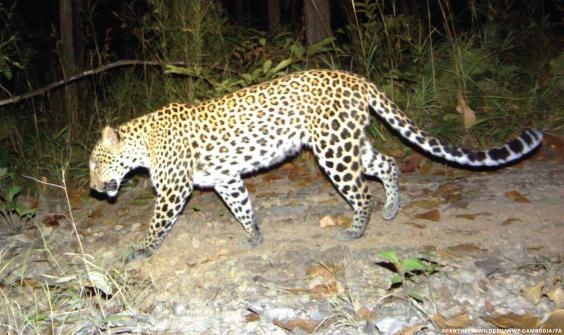 |
| An Indochinese leopard in its natural habitat |
The Asiatic cheetah currently numbers less than 53 in its Iranian homeland, making it one of the most critically endangered of the big cats that is on the brink of extinction. But now, there is another big cat that has and still is suffering the same fate as the Asiatic cheetah: the Indochinese leopard. A recent study has confirmed that the world's last breeding population of leopards in Cambodia is at "immediate risk" of extinction, having dwindled an overwhelming 72 percent in over five years. The research, published in the Royal Society Open Science journal, was carried out in the country's Eastern Plains Landscape and disclosed one of the lowest concentrations ever documented, with a density of one individual per 100 square kilometers. It indicated that that heightened poaching, particularly extensive snaring for the illegal wildlife trade and bushmeat, is to blame for the startling decline. According to the study's co-author and Southeast Asia leopard program coordinator for Panthera, Dr. Jan Kamler, this leopard population "represents the last glimmer of hope" for the animals not just in Cambodia but also Laos and Vietnam. He urged the need to come together in action, not only in words, to suppress the "epidemic of poaching facing this gorgeous big cat and others around the globe." Another co-author, Professor David MacDonald, who is also the director of Oxford University's Wildlife Conservation Research Unit (WildCRU), added that Southeast Asia's leopards are doing "worse than people thought and are heading for catastrophe." Incited by the study's discoveries, Panthera and WildCRU are working with local and national groups to bolster efficient law enforcement and monitoring in the region, which will include the utilization of PoacherCams. A different study recently estimated that just over 1,000 breeding leopards remain in Southeast Asia, but conservationists stated that only 20 to 30 reproductive individuals remain in Cambodia.
 |
| An Indochinese leopard caught on camera trap. |
I cannot think of anything more shocking and heartbreaking than what has been revealed in this study. The Indochinese leopard, like its relative the Asiatic cheetah, is teetering on the brink of extinction due to a large scale of poaching in the form of snare traps for bushmeat and the illegal wildlife trade, loss of habitat, decline in prey, and conflicts with people. I find it outrageous that the illegal wildlife trade continues to operate with impunity, bringing more and more species of wildlife in Southeast Asia and elsewhere in the world closer to extinction on a global scale. I also find it extremely painful and unacceptable that Cambodia has let the tiger become extinct and is now doing the same thing to the leopard I urge the people and the government of Cambodia, as well as in rest of Southeast Asia, to wake up and promptly act upon this issue of Indochinese leopards on the verge of extinction. Otherwise, the international organizations like the IUCN will be forced to declare Cambodia's wildlife conservation, particularly of leopards, a failure just like in the case of Iran's cheetah conservation project. It is a high time to take drastic and efficient action to save both, the Asiatic cheetah and the Indochinese leopard, along with all the other species of big cats as these animals are in a desperate need of help.
View article here
No comments:
Post a Comment